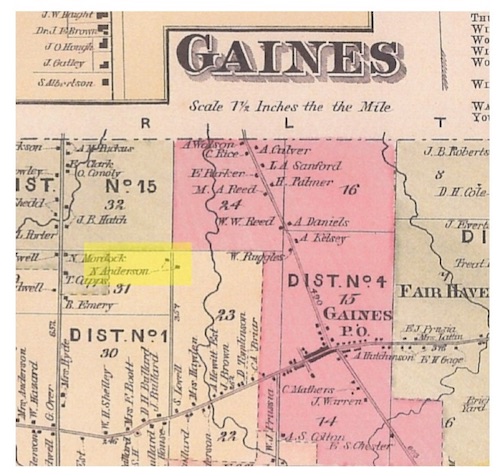Historic Childs: A Sesquicentennial Essay by Sanford B. Church
‘I would gladly give up all of my interest in a rocket to the moon to go back again to 1910 and ride once more behind that old horse in the dust of the Fair Haven Road.’
By Doug Farley, Cobblestone Museum Director – Vol. 2 No. 31
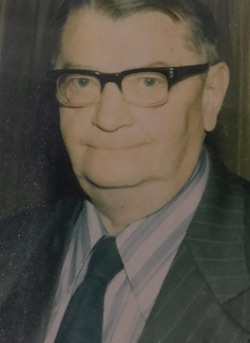
Sanford B. Church, family photo
GAINES – The Hamlet of Childs was by its very location, front and center, during the celebration of the Sesquicentennial of the Town of Gaines in 1959. The milestone of the passage of 150 years of time from 1809-1959 was indeed cause for celebration amongst locals and onlookers, alike. As part of the Sesqui, a 32-page publication was produced that talked about the overall history of the town and reflected on many of the changes that have taken place in the town over the years.
This week’s installment of “Historic Childs” takes a look at an article that was included in the Sesquicentennial publication that featured the reflections of one of its citizens, Sanford B. Church (1904-1976). In his lifetime, Mr. Church practiced law for 40 years and was a founding director of Albion Federal Savings and Loan Association.
He was the owner of the Orleans Republican newspaper, a member of Christ Episcopal Church and Renovations Lodge of Masons. Mr. Church was also the grandfather of current Orleans County Judge Sanford A. Church. The photos included this week were not part of the original essay, but have been included to bring additional understanding to Mr. Church’s remarks.
“Requiescat (Prayer) in Limbo,” by Sanford B. Church, 1959.
This is a chronicle, of sorts, designed with the intention of recalling to the minds of those who read it, some of the customs, practices, institutions which have ceased to be a part of our way of life here in the Town of Gaines during the past fifty years. “Limbo’, according to Webster, is a place or condition of neglect or oblivion, and it is into oblivion that many things we have all known well have passed since 1909. While the loss of some of these causes us no regret, others give a nostalgic tug at our heartstrings and bring back fond memories of a bygone era.

Thompson Farm, Ridge Road, Gaines, late 1800s, showing unpaved Ridge Road. Paving of Ridge Road was not complete until the 1920s.
First and foremost on my list is the passing (or almost) of the dirt road in our town. Certainly, with one exception I can think of, the dirt road as it was fifty years ago has completely ceased to exist. Frankly, I’m sorry. While the modern highways bearing their streams of automobiles from farms to town and maybe still farther away, are an essential part of our current way of life, the little dirt road had a definite charm of its own, and I have always had a special fondness for it in my heart.
In this connection, it is interesting to note that the end of the era of the dirt road was just beginning in Gaines fifty years ago right now. In 1908 the “macadam” road to Gaines was built, and two years later the blacktop road to Fair Haven and beyond was under construction.
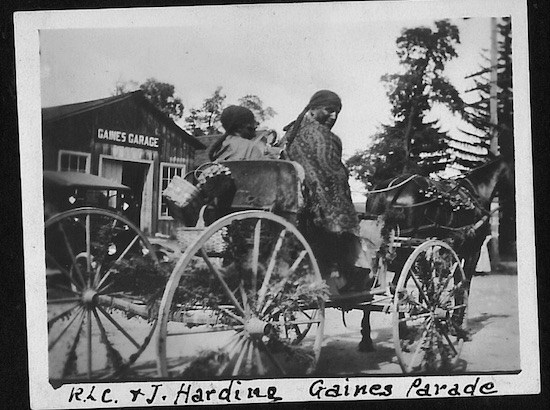
Democrat Wagon from Coloney Farm, Gaines Centennial Parade, 1909
Although I was pretty small back in those days, I can well remember coming home from Oak Orchard in my father’s ‘‘democrat wagon’’ (I suppose it was the station wagon of the time) on a summer’s evening in 1910. At that time there was a large camp for the road workers, and as I recall it was on the west side of the Oak Orchard Road, about a half mile north of the Ridge.
I remember it was dusk, and as the horse plowed his way through the dust, the men were singing and the darkness sparkled with their little fires. In point of time, it was a long drive from Albion to the lake in those days, and many is the buckboard, buggy or democrat we passed on the way, to say nothing of an occasional surrey or phaeton, or a farm wagon creaking and groaning under its load of hay or grain. Such vehicles as these are all gone, so long gone, in fact, that I was startled to see a manure spreader recently on the road not far from Fair Haven (Childs, if you like) drawn by a team of brown horses.
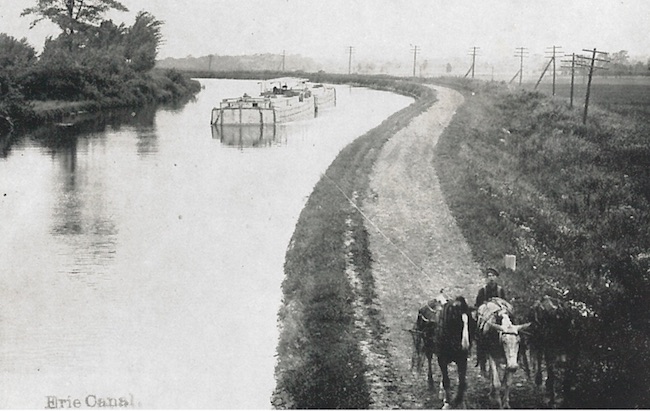
Erie Canal towpath, Gaines Basin, c. 1900 before Barge Canal expansion
Well do I remember blacksmith shops (Joe Vagg’s was the last one to go in Gaines, wasn’t it?). Clure White and his fabulous pond full of goldfish, the old stone mill north of Eagle Harbor, the golf course and country club north of Eagle Harbor, which has both come and gone within this half-century, the towpath along the Erie Canal, the machine shop (maybe you know what work was done there; I don’t) in the rear of the Bacon house in the triangle at Five Corners, the East Gaines store (at the corner of the Kent Road and the Ridge – a vacant lot now), the Congregational Church at Gaines which burned in 1950, Huskin’ Bees, Bees to clear out the drifted roads in winter, and many, many other pleasant, friendly, everyday things.
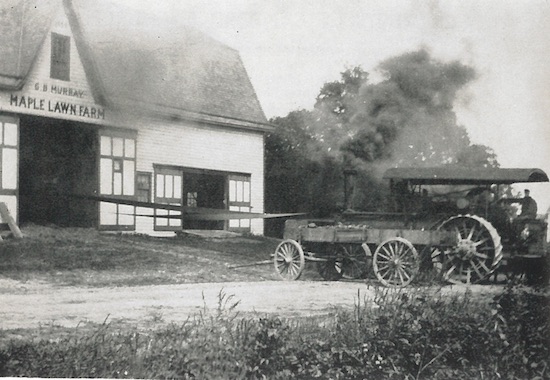
Traction Engine, Maple Lawn Farm, Childs, early 1900s. Note the belt driven power system extending from the engine into the barn.
I can’t remember back to the old, old threshing machine which was propelled by horsepower, and any way that’s back before 1909. But I can distinctly recall the so-called old-fashioned threshing machine, drawn and propelled by a great, smoke-spouting steam “traction engine” which is gone from these parts (although it is in common use in New England, parts of Pennsylvania, and even in other parts of this state).
Almost as good as the arrival of a circus, was the advent of the threshers with their fascinating equipment on a hot summer’s morning. As a child I’ve stood many times in front of the farmhouse where Dan Bolger and his family lived, and seen the men set up the machine, connect the great belt to the traction engine, and bring the wagons loaded with wheat into line. Presently the engine would he belching smoke higher than the barn, the huge spout of the threshing machine would he spewing out straw in a never-ending stream, and the golden grain would run out into the waiting sacks.
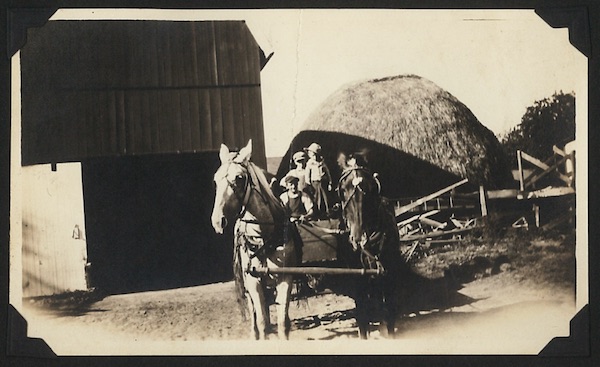
Straw stack, Coloney Farm, Childs, c. 1900.
At noon, the activity would suddenly cease, and after a hasty cleaning-up session, the threshers would crowd about the tables to consume the meal the women had prepared. Then, afterwards, the threshing went on all the afternoon, until all the wheat was threshed, the straw stack was two stories high, and the wheat was sacked and ready for market. It was always an eventful day, an interesting and enthralling sight at the time, and a pleasant memory now.
Windmills exist no longer in Gaines, as far as I know. At least, there are no working ones. But they are by no means totally extinct. There are some still in use in this county, and still more in parts of Genesee and Wyoming. Down in the central part of the state, and in parts of New England, they are very common. For those of you who are doubting Thomases, I respectfully refer you to a brand new aluminum one a half-mile east of Navarino on U. S. 20 (south of Syracuse).
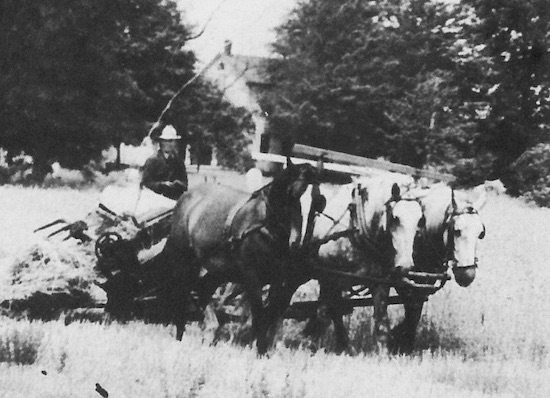
George B. LaMont, horse drawn binder, c. 1930.
To the best of my knowledge, no horse-drawn farm tools are in use in the Town. But, like windmills, they are much in use elsewhere for instance, in eastern Pennsylvania and New England. Likewise with the ‘‘little red schoolhouse.” If you are lonesome for these relics of our youth here in this land of the centralized school of university proportions, go to rural New England. There you will find all of them your heart desires (and without swimming pools!).
One of my informants has assured me that there are no outside privies remaining in Gaines, but I can assure him that he’s wrong. While they are on the wane, they definitely are still very much with us, and I have an idea that they will be for a long, long time to come. But hitching posts (except for ornamentation) are a thing of the past, along with dry houses and evaporators.
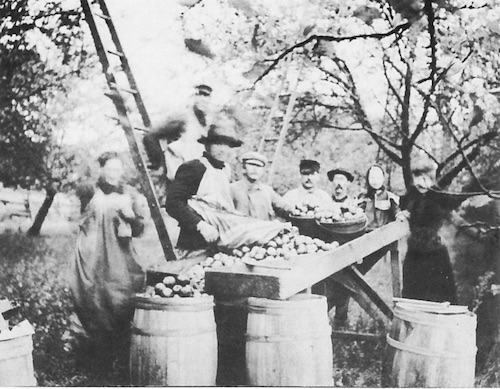
Picking and sorting apples in 1904, LaMont Farm, note use of barrels for storage and shipping.
In my opinion, the cooper shop is deserving of a memorial from the apple growers of the past in Gaines, because the heyday of the barrel was also the heyday of the apple industry in all of this area. In the early part of this century the crop was usually good, and there was an ever-ready seller’s market, particularly overseas. Am I not correct that many of the fine, old homes of Gaines owe their existence to the fact that around 1900 apples were selling at $14 a barrel in foreign ports, notably in the free port of Hamburg.
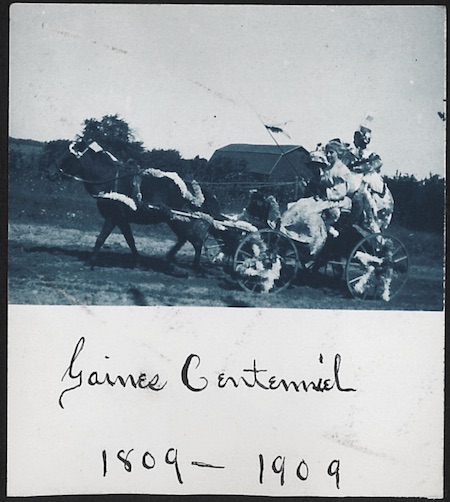
Gaines Sesquicentennial Parade float from Coloney Farms, 1909
And what about circuses and the thrilling parades which always preceded them? And don’t tell me there have been no circuses or circus parades in the Town of Gaines since 1909, because I know better. I’ve watched many a parade go past mv house headed north, turn about (with considerable difficulty) at North Street, and head back up Main Street, with bands playing, flags flying and elephants joined tail-by-trunk in a long line.
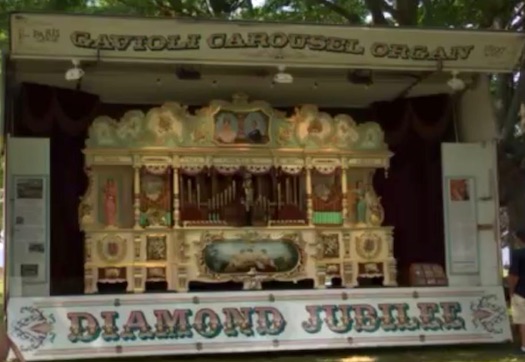
Calliope as seen at Krull Park, Olcott NY, July 2021.
Perhaps the most thrilling part of the parade (to me, at any rate) was the steam calliope, and I can well remember one in particular, which was huge. Of course, as always, it brought up the rear of the parade, and was giving out great clouds of steam all along the route. The player sat on a fancy settee which overhung the rear wheels, and as the vehicle passed under the trees in front of what is now the Lions Club house, the steam descended, completely enveloping player, calliope, horses and all.
As for circuses themselves, I can well remember three back on the Church farm, at least one of which was within the past twenty-five years. But they’ve gone now, not only from Gaines, but from almost everywhere and circus parades, I understand, have completely drifted into oblivion, forever obscured from their clouds of steam from their now silent calliopes.
While modern economists tell us it is a good thing, and a sign of progress, the passing of the small farm makes me sad. The little farm, usually a one-man operation or certainly a one-family operation, was for a long, long time the measure of the American way of life. For generations the families which worked these small places were the real “grass roots” of the country, and the salt of the earth. It is true that some of these small farms are still with us, but each year a few more of them drift into the limbo of the past, along with the asheries with which Gaines was once so liberally blessed.
Paradise Road, not existing today, as seen on this 1913 map, at one time had two cobblestone homes at its northern terminus, north of Ridge Road. One home was owned by Nahum Anderson, great-great-grandfather of retired Historian Bill Lattin. Bill noted that Nahum said the soil on Paradise Road was so poor that “it was only good to hold the rest of the world together.”
And Paradise! Have you ever been to Paradise while the half-dozen houses were still standing? Back then, there was no need of going to the “wild west” to find a ghost town. We had our own right here in Gaines. Just when it was finally abandoned, I don’t know, but it has completely fallen to pieces in the last half-century, and now consists of stones scattered about the meadow at the end of the old Paradise Road.
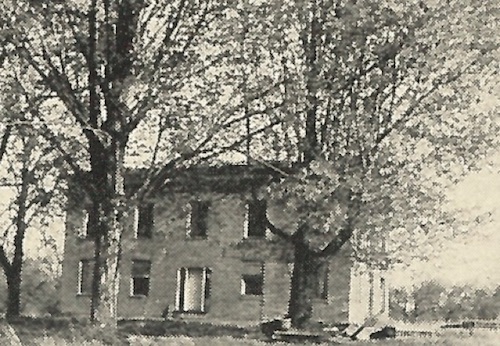
Gaines Academy after a third story had been removed 1930s, Courtesy Town of Gaines Historian
So it was, too, with the old Gaines Academy, except that this institution is marked by a State sign on the south side of the Ridge, across from the Town buildings. The Academy building has completely collapsed into rubble during the past fifty years, but it was, I am informed, abandoned long before that.
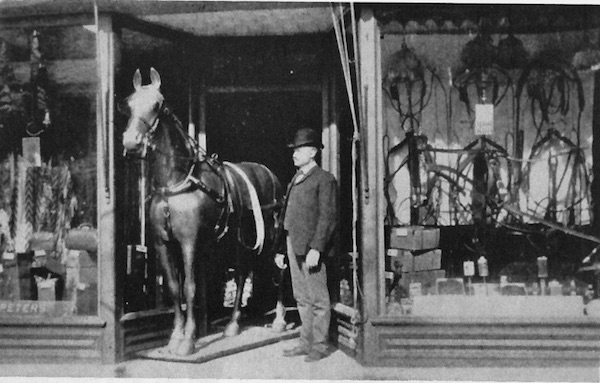
Harness maker Philo Henry Peters is shown here at the entrance of his harness store in Albion, 1905. A sampling of the numerous types of leather goods he produced is seen in the store windows and also on the life-sized horse mannequin he moved outdoors in fair weather.
Harness shops are gone, kerosene lamps (except in emergencies) are no more, and the gas-light era has long since passed. So with the kind of well with an “old oaken bucket” (there were a lot of them fifty years ago).
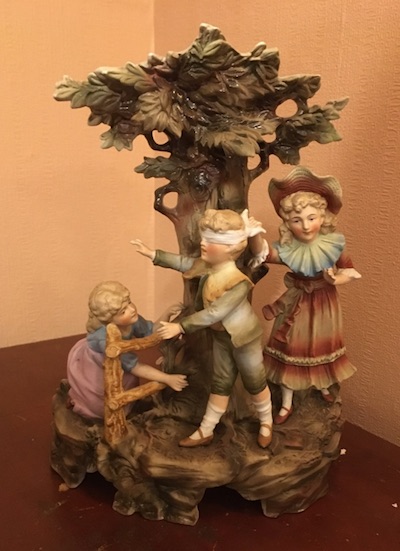
Blind Man’s Bluff, Bisque Figurine, circa 1890
And think of the old children’s games, like Blind Man’s Bluff, Cops and Robbers, and the like. And the songs which have come, been sung and loved, and gone…and the dances…and the celebrations…and the weddings…and all of “those we have loved long since and lost awhile.”
When I come to read this over, now that the space allotted to me is exhausted, I realize something I never thought of when I started: This little chronicle is a half-century slice carved out of the life-time in the Town of Gaines, in the County of Orleans, State of New York. It tells of the way of life in this community during the period 1909-1959, and all that is set forth in it is now history – a history which many of us living have helped to shape.
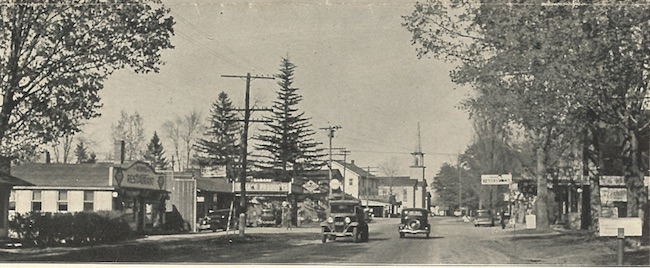
View of Gaines business section looking east along the Ridge Road, 1930s, during the period of recollection by Sanford B. Church.
Progress is wonderful, so I’m told, and we should be duly thankful that we’re living in this modern day and age, with all of its many wonders. Probably this is right, and probably a psychologist would say that I’m simply wishing for my irrevocable youth when I would gladly give up all of my interest in a rocket to the moon, to go back again to 1910 and ride once more behind that old horse in the dust of the Fair Haven Road.




















